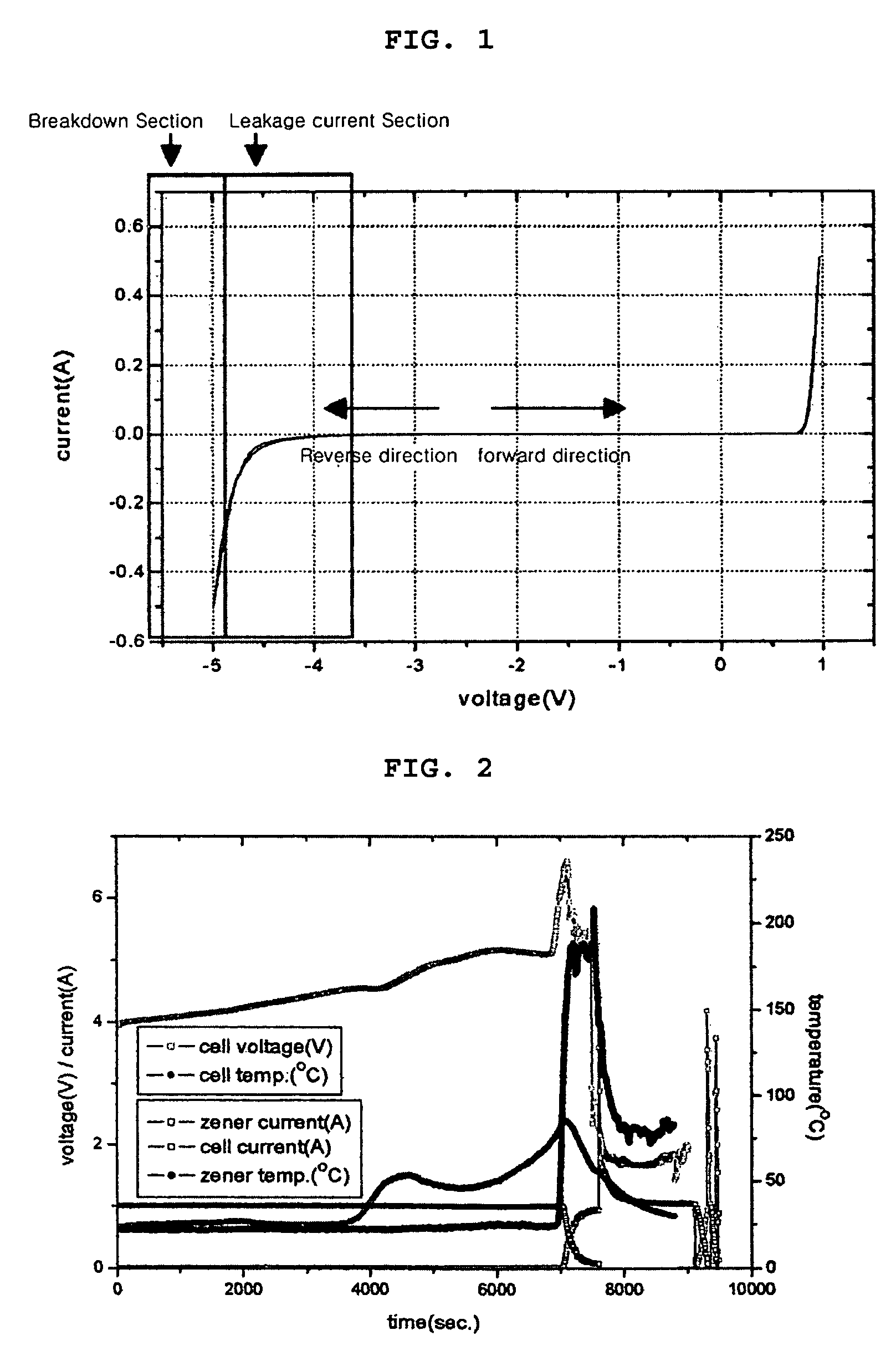Secondary battery having constant-voltage device
a technology of constant voltage and secondary batteries, which is applied in secondary cell servicing/maintenance, cell components, instruments, etc., can solve the problems of secondary battery accidental ignition or explosion, lithium ion battery is vulnerable to overcharge, dangerous accident or property loss, etc., and achieve the effect of preventing explosion or ignition of secondary batteries
- Summary
- Abstract
- Description
- Claims
- Application Information
AI Technical Summary
Benefits of technology
Problems solved by technology
Method used
Image
Examples
example 1
[0057]A secondary battery is prepared with a cathode including a positive active material (LiCoO2), a conducting agent and a binder in a ratio of 95:2.5:2.5 and an anode including a negative active material (carbon), a conducting agent and a binder in a ratio of 94:2:4. In addition, a separator is interposed between the cathode and the anode. An electrolyte including EC and EMC mixed with 1M of LiPF6 is injected into the secondary battery and a pouch is used as an outer case of the secondary battery, thereby obtaining a polymer battery.
[0058]The above battery is a lithium secondary battery having a maximum charge voltage of 4.2V. In addition, the explosion or ignition voltage of the above battery is higher than 12V. A zener diode having a breakdown voltage of about 5 to 12V is connected between the cathode and the anode in a row. Then, the secondary battery is overcharged with 20V-1A. That is, the secondary battery is charged up to 20V using the current of 1Ah. Then, the battery (ce...
example 2
[0065]The test is performed under the same condition as Example 1 except that the secondary battery is overcharged with 33V-1A. The test result is shown in FIG. 3. Similar to Example 1, explosion or ignition of the battery does not occur in Embodiment 2.
[0066](1) The battery (cell) voltage continuously rises as an external voltage is continuously applied to the battery (cell).
[0067](2) The cell temperature starts to increase when the charge voltage of the cell reaches 4.5V.
[0068](3) Discharge of the zener diode starts when the charge voltage of the cell reaches 5.1V, so that the current flows fast through the zener diode and the temperature of the zener diode suddenly rises. However, the cell voltage does not rise above 7V.
[0069](4) As a result of the discharge of the zener diode, the current does not flow through the battery (cell) and explosion or ignition of the battery does not occur.
[0070]As can be seen from FIGS. 2 and 3 illustrating test results of Examples 1 and 2, since the...
PUM
| Property | Measurement | Unit |
|---|---|---|
| breakdown voltage | aaaaa | aaaaa |
| charge voltage | aaaaa | aaaaa |
| breakdown voltage | aaaaa | aaaaa |
Abstract
Description
Claims
Application Information
 Login to View More
Login to View More - R&D
- Intellectual Property
- Life Sciences
- Materials
- Tech Scout
- Unparalleled Data Quality
- Higher Quality Content
- 60% Fewer Hallucinations
Browse by: Latest US Patents, China's latest patents, Technical Efficacy Thesaurus, Application Domain, Technology Topic, Popular Technical Reports.
© 2025 PatSnap. All rights reserved.Legal|Privacy policy|Modern Slavery Act Transparency Statement|Sitemap|About US| Contact US: help@patsnap.com



